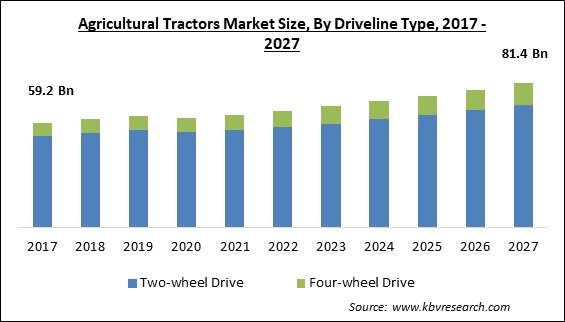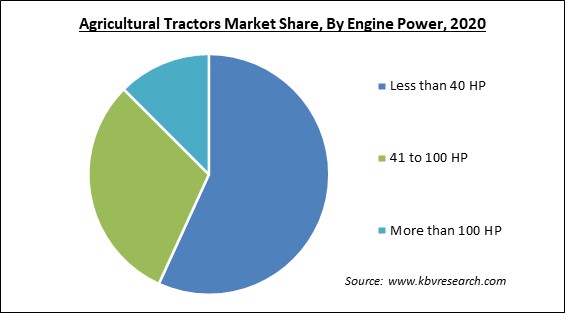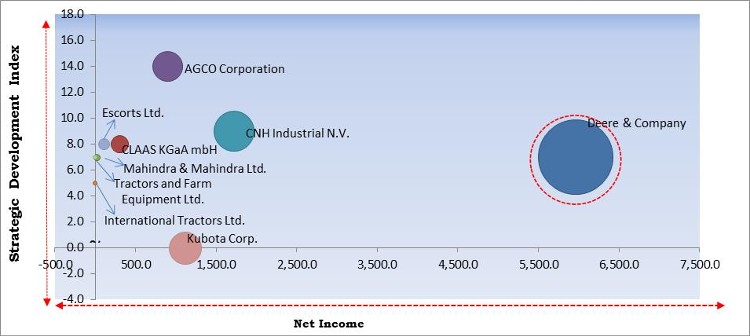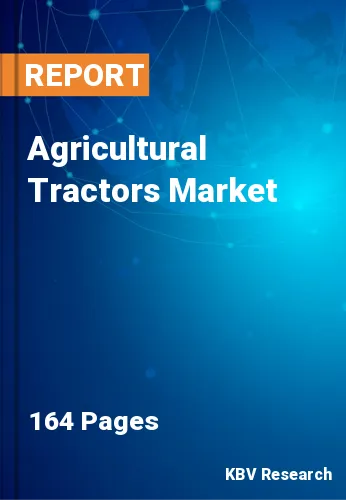The Global Agricultural Tractors Market size is expected to reach $81.4 billion by 2027, rising at a market growth of 4.2% CAGR during the forecast period.
Tractors are defined as vehicles that are developed to travel at low speeds while producing a large amount of torque. Tractors can haul big agricultural implements behind them due to their high torque. In addition, they are also recognized for delivering massive amounts of power, comparable to that of a semi-truck. Tractors are two-wheel drive in most cases. A traditional farm tractor is a straightforward open vehicle with two huge wheels on one axle. Moreover, the agricultural tractor is designed for a variety of agricultural works, including ploughing, tilling, panning, harrowing, planting, and insecticide spraying, as well as pulling or pushing agricultural machinery or trailers. A rise in the demand for productivity and an increase in the deployment of smart farming is driving the agricultural tractors industry.
Some of the major industry trends are the growing demand for compact tractors on small farms and technical developments like the integration of telematics with agricultural tractors. Moreover, the agricultural industry has been witnessing higher adoption of mechanization in the last couple of years. Additionally, the market is expected to rise as farm laborers are migrating to cities, resulting in a labor shortage in the rural areas.
Row crop tractors are the most popular type of agricultural tractor in the world. Several key market companies are investing much in R&D in order to generate cutting-edge technology and maintain a strong market position. Deere & Company introduced the 8 Family Tractor series in 2020, which includes 8R wheel tractors, 8RT two-track tractors, and the first fixed-frame four-track tractors in the industry. In addition, customers can choose the machine configuration, extras, and horsepower that best suit their operation with these new tractors, which come loaded with the latest precision agriculture technologies.

OEMs are presently facing a semiconductor shortage, as well as supply chain interruptions and market uncertainty, as a result of the consistently increasing COVID-19 cases, which may cause manufacturing delays. In addition, an increase in steel and aluminum costs is predicted to raise tractor prices, which is expected to slow market development in the coming quarters. The United States Department of Agricultural (USDA) introduced the Precision Agriculture Loan (PAL) Act on September 15, 2021, to allow farmers and ranchers to obtain loans to buy precision agriculture equipment. Tractor demand rebounded considerably in H1 2021, in major economies such as the United States, Canada, the United Kingdom, Germany, China, and India. In addition, in 2021, robust crop output in these areas, as well as the requirement to substitute aged equipment, fuelled the demand and sale of agriculture machines.
Because their engines have a size of less than 1,500 cc, these tractors take up less space and are more adaptable. Because of the ease of customization, manufacturers are more likely to experiment with novel components and technologies in this category before moving on to higher-powered ones. These tractors are small, with a PTO horsepower of less than 40 and a weight of less than 4,000 pounds. In addition, Schools, landscapers, parks, cemeteries, and hobby farmers all use this high-production, cost-effective, and user-friendly compact tractors. Low horsepower tractors are useful in soft soil conditions, such as river basins. Moreover, horticulture is the primary application for tractors with less than 40 horsepower.
Tractor demand is increasing as the world's population grows. Some of the key trends of the market are rapid urbanization, limited labor accessibility, rising food consumption, and technological innovation. When simple demand-supply economics and the flow of labor from urban to rural areas are taken into account, the cost of farm labor has a direct link with the percentage of a country's entire population employed in agriculture. In addition, farmers are expected to boost their yields as the population and demand for food grow. Moreover, agricultural tractors play a vital role in raising agricultural output in India. In recent years, the rising preference for lower-power output tractors, as well as the greater penetration of self-driving tractors, has been witnessed.
Tractors and harvesters, for example, constitute a big investment in agricultural activities and are responsible for a significant portion of the global rental business. The cost of the machinery available to farmers reflects all of the procedures involved in designing, producing, and distributing the equipment. Farm equipment penetration in emerging countries is low due to small farmers' incapacity to invest a large sum of money. Farmers choose to hire farm machinery to boost output and turnaround time, which boosts the overall efficiency and profitability. When compared to purchasing agricultural equipment with a traditional loan from a financial institution, renting farm equipment is more cost-effective.

Based on Driveline Type, the market is segmented into Two-wheel Drive, and Four-wheel Drive. In 2020, the 2WD segment procured the maximum revenue share of the Agricultural Tractors Market. This is because long-term considerations such as lower upfront costs and improved mobility are projected to promote demand in the 2WD segment, particularly in the Asia Pacific market. In India, 2WD tractors are the most popular among middle-income farmers. Hence, these factors are anticipated to drive the growth of this segment over the forecast years.
Based on Engine Power, the market is segmented into Less than 40 HP, 41 to 100 HP, and More than 100 HP. The 41 to 100 HP segment held a significant revenue share of the Agricultural Tractors Market in 2020. This is because of an increase in demand for these tractors in developed markets like the United States, Japan, and Germany. In addition, factors such as greater disposable income, tech-savvy farmers, and well-established after-sales services are expected to boost the growth of this segment. Moreover, long-term factors such as increased demand for high-power tractors for farms larger than 10 hectares are likely to drive the segment growth during the forecasting period.
| Report Attribute | Details |
|---|---|
| Market size value in 2020 | USD 62 Billion |
| Market size forecast in 2027 | USD 81.4 Billion |
| Base Year | 2020 |
| Historical Period | 2017 to 2019 |
| Forecast Period | 2021 to 2027 |
| Revenue Growth Rate | CAGR of 4.2% from 2021 to 2027 |
| Number of Pages | 164 |
| Number of Tables | 253 |
| Report coverage | Market Trends, Revenue Estimation and Forecast, Segmentation Analysis, Regional and Country Breakdown, Competitive Landscape, Companies Strategic Developments, Company Profiling |
| Segments covered | Driveline Type, Engine Power, Region |
| Country scope | US, Canada, Mexico, Germany, UK, France, Russia, Spain, Italy, China, Japan, India, South Korea, Australia, Malaysia, Brazil, Argentina, UAE, Saudi Arabia, South Africa, Nigeria |
| Growth Drivers |
|
| Restraints |
|
Based on Regions, the market is segmented into North America, Europe, Asia Pacific, and Latin America, Middle East & Africa. In 2020, the APAC emerged as the leading region in the overall Agricultural Tractors Market. This is because of the countries like India, where more than 70% population is still employed in agricultural and related activities. In addition, product sales in India are estimated to exceed 900,000 units. In 2022, the regional market is predicted to develop due to easy loan availability, a favorable Minimum Support Price (MSP), and a better monsoon.
Free Valuable Insights: Global Agricultural Tractors Market size to reach USD 81.4 Billion by 2027

The major strategies followed by the market participants are Product Launches. Based on the Analysis presented in the Cardinal matrix; Deere & Company is the forerunners in the Agricultural Tractors Market. Companies such as AGCO Corporation, CNH Industrial N.V., Kubota Corp. are some of the key innovators in the Market.
The market research report covers the analysis of key stake holders of the market. Key companies profiled in the report include AGCO Corporation, CNH Industrial N.V., Deere & Company, CLAAS KGaA mbH, Escorts Ltd., International Tractors Ltd., Yanmar Co., Ltd., Kubota Corp., Mahindra & Mahindra Ltd., and Tractors and Farm Equipment Ltd.
By Driveline Type
By Engine Power
By Geography
The global agricultural tractors market size is expected to reach $81.4 billion by 2027.
Farm Mechanization in Emerging Economies are driving the market in coming years, however, the highly thriving rental industry limited the growth of the market.
AGCO Corporation, CNH Industrial N.V., Deere & Company, CLAAS KGaA mbH, Escorts Ltd., International Tractors Ltd., Yanmar Co., Ltd., Kubota Corp., Mahindra & Mahindra Ltd., and Tractors and Farm Equipment Ltd.
The expected CAGR of the agricultural tractors market is 4.2% from 2021 to 2027.
The Less than 40 HP market dominated the Global Agricultural Tractors Market by Engine Power 2020, thereby, achieving a market value of $45.2 billion by 2027.
The Asia Pacific market dominated the Global Agricultural Tractors Market by Region 2020, and would continue to be a dominant market till 2027.
Our team of dedicated experts can provide you with attractive expansion opportunities for your business.

